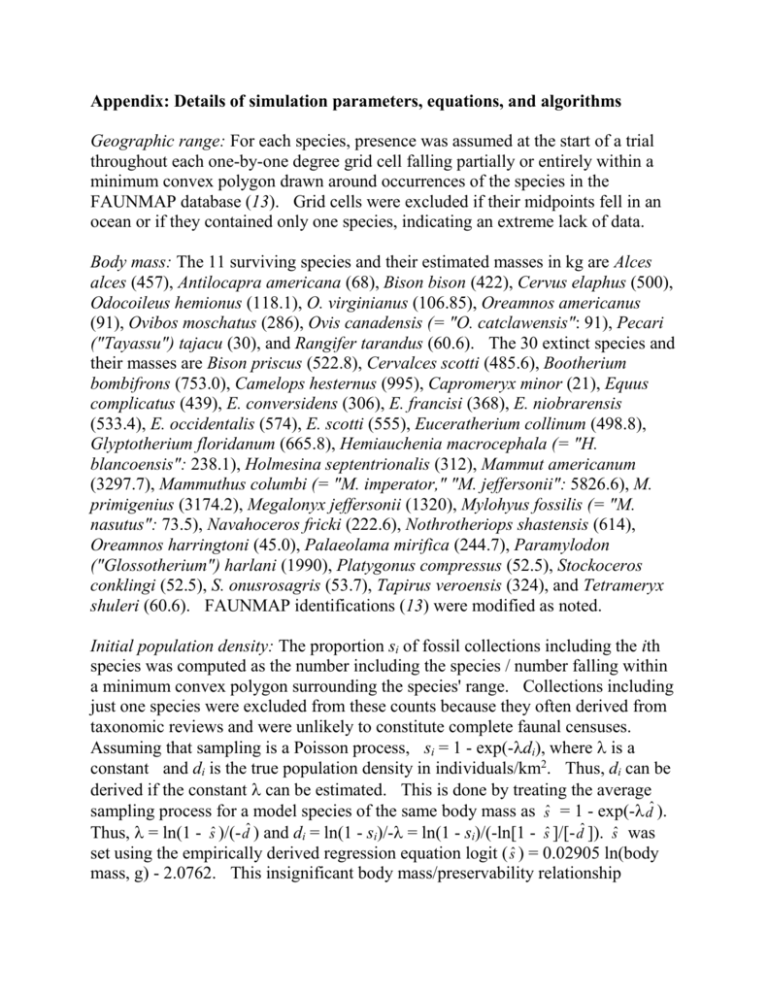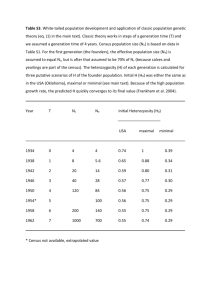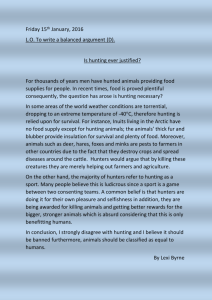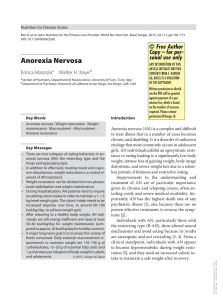Appendix: Simulation parameters, equations, and algorithms
advertisement

Appendix: Details of simulation parameters, equations, and algorithms Geographic range: For each species, presence was assumed at the start of a trial throughout each one-by-one degree grid cell falling partially or entirely within a minimum convex polygon drawn around occurrences of the species in the FAUNMAP database (13). Grid cells were excluded if their midpoints fell in an ocean or if they contained only one species, indicating an extreme lack of data. Body mass: The 11 surviving species and their estimated masses in kg are Alces alces (457), Antilocapra americana (68), Bison bison (422), Cervus elaphus (500), Odocoileus hemionus (118.1), O. virginianus (106.85), Oreamnos americanus (91), Ovibos moschatus (286), Ovis canadensis (= "O. catclawensis": 91), Pecari ("Tayassu") tajacu (30), and Rangifer tarandus (60.6). The 30 extinct species and their masses are Bison priscus (522.8), Cervalces scotti (485.6), Bootherium bombifrons (753.0), Camelops hesternus (995), Capromeryx minor (21), Equus complicatus (439), E. conversidens (306), E. francisi (368), E. niobrarensis (533.4), E. occidentalis (574), E. scotti (555), Euceratherium collinum (498.8), Glyptotherium floridanum (665.8), Hemiauchenia macrocephala (= "H. blancoensis": 238.1), Holmesina septentrionalis (312), Mammut americanum (3297.7), Mammuthus columbi (= "M. imperator," "M. jeffersonii": 5826.6), M. primigenius (3174.2), Megalonyx jeffersonii (1320), Mylohyus fossilis (= "M. nasutus": 73.5), Navahoceros fricki (222.6), Nothrotheriops shastensis (614), Oreamnos harringtoni (45.0), Palaeolama mirifica (244.7), Paramylodon ("Glossotherium") harlani (1990), Platygonus compressus (52.5), Stockoceros conklingi (52.5), S. onusrosagris (53.7), Tapirus veroensis (324), and Tetrameryx shuleri (60.6). FAUNMAP identifications (13) were modified as noted. Initial population density: The proportion si of fossil collections including the ith species was computed as the number including the species / number falling within a minimum convex polygon surrounding the species' range. Collections including just one species were excluded from these counts because they often derived from taxonomic reviews and were unlikely to constitute complete faunal censuses. Assuming that sampling is a Poisson process, si = 1 - exp(-di), where is a constant and di is the true population density in individuals/km2. Thus, di can be derived if the constant can be estimated. This is done by treating the average sampling process for a model species of the same body mass as sˆ = 1 - exp(- dˆ ). Thus, = ln(1 - sˆ )/(- dˆ ) and di = ln(1 - si)/-= ln(1 - si)/(-ln[1 - sˆ ]/[- dˆ ]). sˆ was set using the empirically derived regression equation logit ( sˆ ) = 0.02905 ln(body mass, g) - 2.0762. This insignificant body mass/preservability relationship explains only 4.7% of the variance, perhaps because slower decay and weathering of large species is counter-balanced by higher per-annum mortality of smaller species. dˆ was set to exp(1.592 - 0.2622 ln[body mass, g]) (18). Prey population growth: Dynamics were based on the discrete logistic growth equation Nt+1 = Ntexp(r(1-Nt/K)), where Nt = population in a grid cell at time t; r = the intrinsic (maximal) rate of increase, set to equal exp(1.4967 - 0.37 ln[body mass, g]) (19); and k = carrying capacity, set to equal the initial population size. Logistic density dependence implies that extinction is impossible without a strong perturbation. Secondary food resources: Productivity of plant and small game foods was assumed to be 200 g/m2 for all geographic regions because areas with higher net primary productivity than this probably yield relatively less edible plant resources (9). Of this amount, 2% was assumed to be edible (9). Regrowth was modelled with logistic dynamics, with the intrinsic rate of increase set to 22% the initial value (9). Caloric values were set to 3 kcal/g (13), which is similar to estimates used in other simulations (10). Because a significant amount of small game is incorporated in the secondary resource budget, the caloric value of big game and secondary resources is probably very similar (21), so no difference was assumed. Human nutrition: The standard caloric intake i0 value of 2200 kcal/person/day compares to those used in other simulations: 1862 (9), 1975 (21), 2200 (11), and 2505 (10) kcal/person/day. An independent source gives a range of 1700 - 2700 kcal/person/day for contemporary human populations (22). The materials gathered:materials ratio is conservative because much higher big game wastage values were used in some early models (5-7, 9); the value of 1.4 is in the range assumed by later, more conservative researchers (1.33: 10; 1.54: 11). Human hunting and gathering ability: Baseline hunting success rates h' in grams were set by summing miNi(1-aeNh) across all prey species, where mi = body mass and Ni = population size of the ith species in a grid cell, a = hunting ability constant (see Table 1), and Nh = human population size. Realized rates were modulated by a type 2 functional response (23) of the form h = (3.5h'/hk)/(1+2.5h'/hk), where hk = hunting rate at equilibrium. These equations imply that hunting is a random Poisson process: success is proportional to the density of both food items and humans, and humans interfere with each other's capture rates at high human population densities. Hunting success increases by no more than a factor of 1.4 as projected intake approaches zero due to lack of resources; likewise, actual intake is never greater than 1.4i0 at high prey densities. The figure of 1.4 is justified assuming that maximum normal digestive capacity is 1050 ml/day (21) and that food has a nutritional value of 3 kcal/g and a density of about 1.0 g/ml, which yields (3150/2200) kcal/day = 1.39 times the standard requirement. Human population growth: Growth rt at time t was assumed to be zero if actual caloric intake it equalled the standard rate i0, and maximal if intake equalled the maximum of 1.4i0. Maximal rates of growth of 4%/yr for hunter-gatherer populations are known (4, 11, contra 24, 25), but earlier studies have used lower values (2.0%: 11; 2.9%: 9; 3.0%: 4; < 3.5%: 7). A compromise value of 3% is used here. Assuming this, then the relationship rt = (it /i0)0.0878 yields rt = 3.00%/yr when intake is maximal and rt = -5.90%/yr when intake is half of the standard rate. Realized population growth rates were never > 2% (Table 1), because input hunting parameters never allowed maximal kill rates to be attained. Timing: Starting simulations with an initial invading population of 100 humans at 14,000 B.P., allowed enough time before the 13,400 B.P. appearance of Clovis artifacts (3) to make sure that detectable human populations would spread to the Southwest by that date. Some extinct megafauna may have survived to 12,260 B.P. (or 10,370 B.P. uncalibrated: 26), which is during the Younger Dryas global cooling event. Therefore, simulation trials were terminated at 11,500 B.P., just after the end the Younger Dryas (11,530 B. P. calibrated: 3). The total run time of 2500 years should be long enough to encompass any realistic extinction pulse. Human dispersal: Rates of population change in each grid cell were determined by a standard difference equation that computes net growth as a summation across larger populations in the eight nearest cells. A diffusion coefficient of 900 was assumed (4), and the initial population was placed at 49˚ N 114˚ W in most simulations, following Refs. 4, 6, and 7. Interspecific competition: The competion model assumed that each species' population growth was a Ricker logistic function of its own density plus the population densities of all other species times a competition coefficient c. When c = 0, there is no competition and all species have independent logistic population dynamics; when c = 1, all species behave as an undifferentiated ecological unit. Population sizes were weighted by mass0.75 so they would reflect energy intake per unit time instead of standing population size (i.e., Kleiber's law that metabolic rates scale to the 0.75 power in mammals: 27). Prey species dispersal: The first set of simulations forbid dispersal between grid cells, making population dynamics completely independent in each cell. The second set evenly redistributed the total population of each species across all cells falling in the species' original geographic range. Redistribution was performed once per year.







